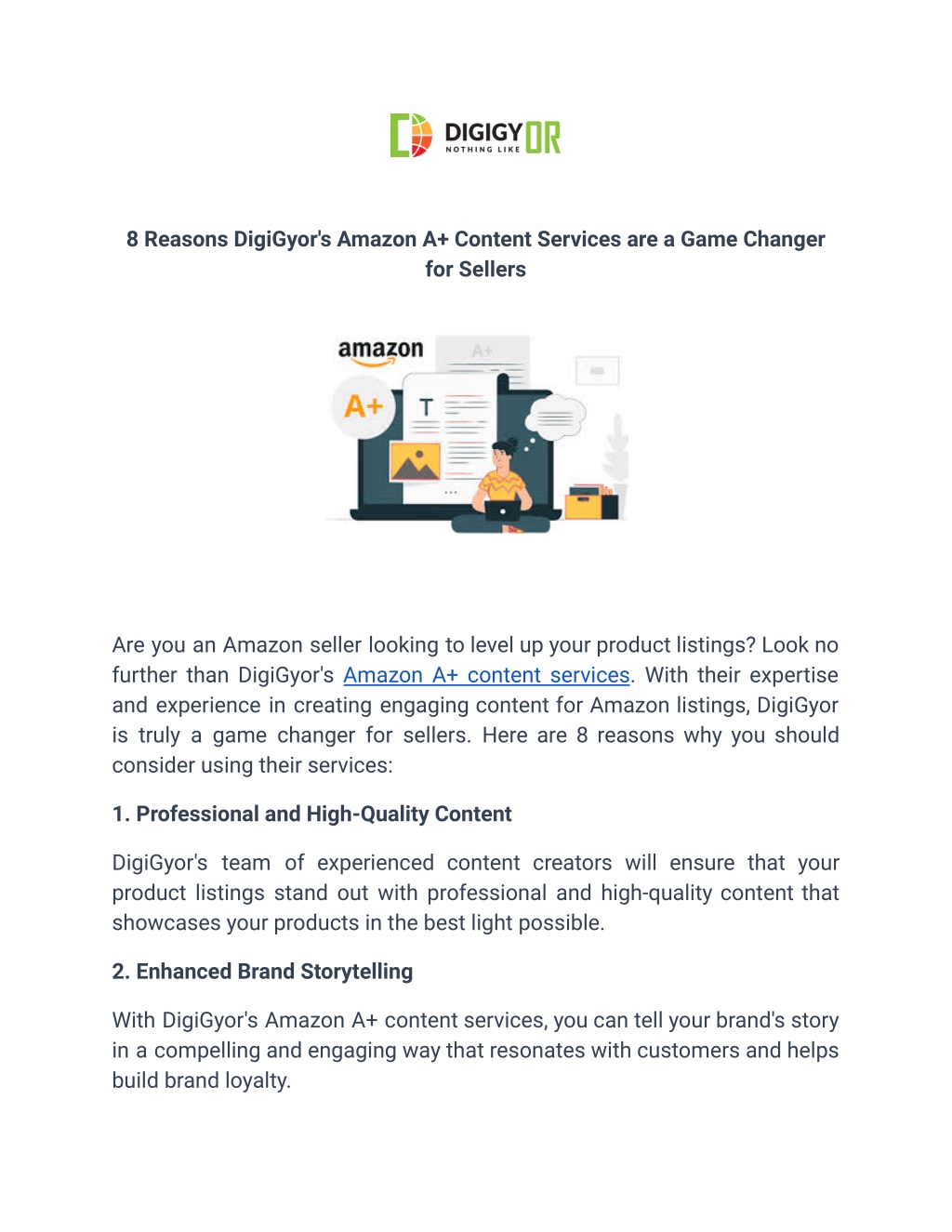Why Amazon Storefronts Are a Game-Changer for Online Sellers
Having an Amazon storefront can be a game-changer for online sellers, offering a multitude of benefits that can help take their business to the next level. One of the most significant advantages of having an Amazon storefront is increased visibility. With millions of customers shopping on Amazon every day, a storefront provides a professional and dedicated space for sellers to showcase their products and brand. This increased visibility can lead to more sales, as customers are more likely to trust and purchase from a seller with a professional storefront.
In addition to increased visibility, an Amazon storefront also lends credibility to a seller’s business. A well-designed storefront can help establish a seller’s brand identity and make their products stand out from the competition. This can be especially important for new sellers who are looking to establish themselves on the platform. By having a professional storefront, sellers can demonstrate their commitment to providing high-quality products and excellent customer service.
Another benefit of having an Amazon storefront is the potential for increased sales. With a storefront, sellers can showcase their products in a more visually appealing way, making it easier for customers to find and purchase the products they are looking for. Additionally, a storefront provides sellers with the opportunity to promote their products through Amazon’s advertising options, such as Sponsored Products and Sponsored Brands.
For sellers looking to learn how to make money on Amazon storefront, having a well-designed storefront is essential. By providing a professional and dedicated space for their products, sellers can increase their visibility, credibility, and sales. With the right strategies and techniques, sellers can unlock the full potential of their Amazon storefront and take their business to new heights.
Setting Up Your Storefront for Success: Essential Steps to Follow
Setting up a successful Amazon storefront requires careful planning and attention to detail. To help sellers get started, here is a step-by-step guide on how to set up an Amazon storefront:
Step 1: Choose a Store Name
The first step in setting up an Amazon storefront is to choose a store name. This name will be the identity of the seller’s brand and will be displayed on the storefront. It’s essential to choose a name that is unique, memorable, and relevant to the products being sold.
Step 2: Create a Logo
A logo is a crucial element of a seller’s brand identity. It should be visually appealing, scalable, and relevant to the products being sold. Amazon recommends using a logo that is at least 400 x 400 pixels in size.
Step 3: Select a Template
Amazon offers a range of pre-designed templates that sellers can use to create their storefront. These templates are customizable, and sellers can choose the one that best fits their brand and products.
Step 4: Write a Clear and Concise Store Description
A store description is a critical element of an Amazon storefront. It should clearly and concisely describe the seller’s brand, products, and values. The description should also include relevant keywords to help with search engine optimization (SEO).
Step 5: Add Products and Categories
Once the storefront is set up, sellers can start adding products and categories. It’s essential to organize products into relevant categories to make it easy for customers to find what they’re looking for.
By following these steps, sellers can set up a professional and effective Amazon storefront that will help them to succeed in the competitive world of e-commerce. For sellers looking to learn how to make money on Amazon storefront, a well-designed storefront is essential. It provides a solid foundation for building a successful business and attracting customers.
Optimizing Your Product Listings for Maximum Visibility
Optimizing product listings is crucial for increasing visibility and driving sales on Amazon. A well-optimized product listing can help sellers stand out from the competition and attract more customers to their storefront. Here are some tips on how to optimize product listings for better visibility:
Use Relevant Keywords
Using relevant keywords in product titles, descriptions, and tags is essential for improving visibility in Amazon search results. Sellers should conduct thorough keyword research to identify the most relevant and high-traffic keywords for their products.
High-Quality Product Images
High-quality product images are essential for showcasing products in the best possible light. Sellers should use high-resolution images that clearly show the product from different angles. Amazon recommends using images that are at least 1000 x 1000 pixels in size.
Detailed Product Descriptions
Detailed product descriptions are crucial for providing customers with the information they need to make informed purchasing decisions. Sellers should include detailed information about the product, including its features, benefits, and specifications.
Accurate Product Categorization
Accurate product categorization is essential for ensuring that products appear in the correct search results. Sellers should carefully select the most relevant categories and subcategories for their products to ensure that they appear in front of the right customers.
By optimizing product listings with relevant keywords, high-quality product images, detailed product descriptions, and accurate product categorization, sellers can increase their visibility and drive more sales on Amazon. For sellers looking to learn how to make money on Amazon storefront, optimizing product listings is a critical step in building a successful business.
Additionally, sellers should also keep in mind the importance of product reviews and ratings. Encouraging customers to leave reviews and ratings can help increase visibility and credibility, and can also provide valuable feedback for improving product listings and customer service.
Leveraging Amazon Advertising to Boost Sales and Revenue
Amazon advertising is a powerful tool for sellers looking to increase their visibility, drive sales, and boost revenue. With millions of products competing for attention on Amazon, advertising can help sellers stand out from the competition and reach their target audience. In this section, we’ll explore the different types of Amazon advertising options and how to use them to drive success.
Sponsored Products
Sponsored Products is a popular Amazon advertising option that allows sellers to promote their products at the top and bottom of search results pages. This type of advertising is ideal for sellers who want to increase their product’s visibility and drive sales. Sponsored Products ads are pay-per-click, meaning sellers only pay when a customer clicks on their ad.
Sponsored Brands
Sponsored Brands is another Amazon advertising option that allows sellers to promote their brand and products on Amazon. This type of advertising is ideal for sellers who want to increase their brand’s visibility and drive sales. Sponsored Brands ads are also pay-per-click, meaning sellers only pay when a customer clicks on their ad.
Benefits of Amazon Advertising
Amazon advertising offers a range of benefits for sellers, including increased visibility, sales, and revenue. By using Amazon advertising, sellers can reach their target audience and drive sales. Additionally, Amazon advertising provides sellers with valuable insights and data on their ad performance, allowing them to optimize their campaigns for better results.
For sellers looking to learn how to make money on Amazon storefront, Amazon advertising is a crucial component of a successful sales strategy. By leveraging Amazon advertising, sellers can increase their visibility, drive sales, and boost revenue. Whether you’re just starting out or looking to scale your business, Amazon advertising can help you achieve your goals.
Best Practices for Amazon Advertising
To get the most out of Amazon advertising, sellers should follow best practices, including targeting the right audience, using relevant keywords, and optimizing ad campaigns for better results. Sellers should also monitor their ad performance regularly and make adjustments as needed to ensure optimal results.
Utilizing Amazon Fulfillment Options to Streamline Your Business
Amazon offers various fulfillment options to help sellers streamline their business and improve customer satisfaction. In this section, we’ll discuss the different Amazon fulfillment options, including Fulfillment by Amazon (FBA) and Merchant Fulfilled.
Fulfillment by Amazon (FBA)
FBA is a popular fulfillment option that allows sellers to store their products in Amazon’s warehouses. When a customer places an order, Amazon handles the packaging, shipping, and customer service. FBA offers several benefits, including fast and reliable shipping, customer service, and returns handling.
Benefits of FBA
Using FBA can help sellers improve their customer satisfaction and increase their sales. With FBA, sellers can offer fast and reliable shipping, which can lead to higher customer satisfaction and more positive reviews. Additionally, FBA handles customer service and returns, which can save sellers time and reduce their workload.
Merchant Fulfilled
Merchant Fulfilled is another fulfillment option that allows sellers to handle their own shipping and customer service. This option is ideal for sellers who want to maintain control over their shipping and customer service. However, it requires more time and effort to handle these tasks.
Choosing the Right Fulfillment Option
When choosing a fulfillment option, sellers should consider their business needs and goals. FBA is a good option for sellers who want to improve their customer satisfaction and increase their sales. However, it requires a fee, which can eat into sellers’ profit margins. Merchant Fulfilled is a good option for sellers who want to maintain control over their shipping and customer service.
For sellers looking to learn how to make money on Amazon storefront, choosing the right fulfillment option is crucial. By utilizing Amazon’s fulfillment options, sellers can streamline their business, improve customer satisfaction, and increase their sales.
Best Practices for Fulfillment
To get the most out of Amazon’s fulfillment options, sellers should follow best practices, including accurately tracking inventory, using Amazon’s shipping labels, and responding promptly to customer inquiries. By following these best practices, sellers can ensure that their customers receive their orders quickly and efficiently, which can lead to higher customer satisfaction and more positive reviews.
Monitoring and Analyzing Your Storefront’s Performance
Monitoring and analyzing your storefront’s performance is crucial for making informed business decisions and optimizing your sales strategy. Amazon provides a range of performance metrics that can help you track your storefront’s performance and identify areas for improvement.
Amazon Performance Metrics
Amazon’s performance metrics include sales, revenue, and customer reviews. These metrics can help you track your storefront’s performance over time and identify trends and patterns. For example, you can use sales and revenue metrics to track your storefront’s overall performance and identify which products are driving the most sales.
Customer Reviews
Customer reviews are an important metric for tracking your storefront’s performance. Positive reviews can help increase your storefront’s visibility and drive more sales, while negative reviews can harm your reputation and drive sales down. By monitoring customer reviews, you can identify areas for improvement and make changes to your products and customer service to increase customer satisfaction.
Using Data to Make Informed Business Decisions
By monitoring and analyzing your storefront’s performance, you can make informed business decisions that drive sales and revenue. For example, if you notice that a particular product is driving a lot of sales, you can optimize your listings for that product to increase visibility and drive even more sales.
For sellers looking to learn how to make money on Amazon storefront, monitoring and analyzing performance metrics is essential. By tracking your storefront’s performance and making data-driven decisions, you can optimize your sales strategy and drive long-term success.
Best Practices for Monitoring and Analyzing Performance
To get the most out of Amazon’s performance metrics, sellers should follow best practices, including regularly monitoring metrics, analyzing trends and patterns, and making data-driven decisions. By following these best practices, sellers can optimize their sales strategy and drive long-term success.
Additionally, sellers should also use Amazon’s performance metrics to identify areas for improvement and make changes to their products and customer service to increase customer satisfaction. By providing excellent customer service and offering high-quality products, sellers can increase customer loyalty and drive repeat business.
Building a Loyal Customer Base through Excellent Customer Service
Providing excellent customer service is crucial for building a loyal customer base and driving long-term success on Amazon. By responding to customer reviews and resolving issues promptly, sellers can demonstrate their commitment to customer satisfaction and build trust with their customers.
Responding to Customer Reviews
Responding to customer reviews is an essential part of providing excellent customer service on Amazon. By responding to both positive and negative reviews, sellers can show their customers that they value their feedback and care about their experience. This can help to build trust and increase customer loyalty.
Resolving Issues Promptly
Resolving issues promptly is also critical for providing excellent customer service on Amazon. By responding quickly to customer inquiries and resolving issues efficiently, sellers can demonstrate their commitment to customer satisfaction and build trust with their customers.
Personalized Communication
Personalized communication is another key aspect of providing excellent customer service on Amazon. By addressing customers by name and tailoring communication to their specific needs, sellers can create a more personal and human experience for their customers. This can help to build trust and increase customer loyalty.
Incentives
Offering incentives is also a great way to build a loyal customer base on Amazon. By offering discounts, free shipping, or other perks, sellers can reward their customers for their loyalty and encourage them to continue shopping with their storefront.
For sellers looking to learn how to make money on Amazon storefront, providing excellent customer service is essential. By responding to customer reviews, resolving issues promptly, and offering personalized communication and incentives, sellers can build a loyal customer base and drive long-term success.
Best Practices for Customer Service
To get the most out of customer service on Amazon, sellers should follow best practices, including responding to customer reviews and resolving issues promptly, using personalized communication, and offering incentives. By following these best practices, sellers can build a loyal customer base and drive long-term success.
Additionally, sellers should also use Amazon’s customer service tools to streamline their customer service operations and improve their response times. By using these tools, sellers can provide faster and more efficient customer service, which can help to build trust and increase customer loyalty.
Scaling Your Amazon Storefront for Long-Term Success
Scaling your Amazon storefront for long-term success requires careful planning and execution. By expanding your product offerings, optimizing your listings for seasonal demand, and leveraging Amazon’s promotional tools, you can increase your sales and revenue and build a loyal customer base.
Expanding Product Offerings
Expanding your product offerings is a great way to scale your Amazon storefront. By offering a wider range of products, you can attract more customers and increase your sales. Consider adding new products that are related to your existing products or that complement your existing product line.
Optimizing Listings for Seasonal Demand
Optimizing your listings for seasonal demand is another way to scale your Amazon storefront. By adjusting your product listings to reflect seasonal demand, you can increase your sales and revenue during peak seasons. Consider using keywords related to seasonal demand and adjusting your product descriptions to reflect the current season.
Leveraging Amazon’s Promotional Tools
Leveraging Amazon’s promotional tools is a great way to scale your Amazon storefront. By using Amazon’s promotional tools, such as Lightning Deals and Deals of the Day, you can increase your sales and revenue and attract more customers. Consider using Amazon’s promotional tools to promote your products during peak seasons or to clear out inventory.
For sellers looking to learn how to make money on Amazon storefront, scaling their storefront for long-term success is essential. By expanding their product offerings, optimizing their listings for seasonal demand, and leveraging Amazon’s promotional tools, sellers can increase their sales and revenue and build a loyal customer base.
Best Practices for Scaling Your Storefront
To get the most out of scaling your Amazon storefront, sellers should follow best practices, including expanding their product offerings, optimizing their listings for seasonal demand, and leveraging Amazon’s promotional tools. By following these best practices, sellers can increase their sales and revenue and build a loyal customer base.
Additionally, sellers should also consider using Amazon’s analytics tools to track their sales and revenue and adjust their strategies accordingly. By using Amazon’s analytics tools, sellers can gain valuable insights into their customers’ behavior and preferences and adjust their strategies to meet their needs.




